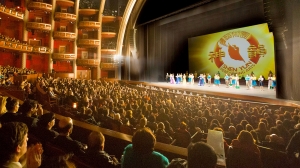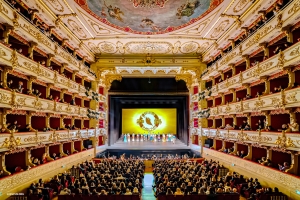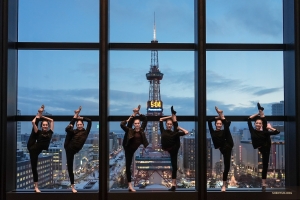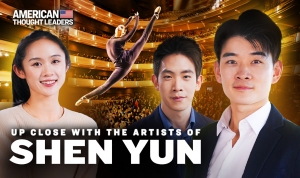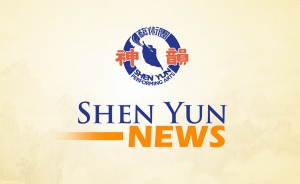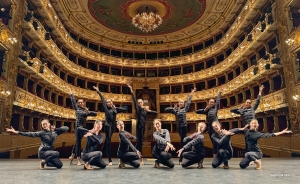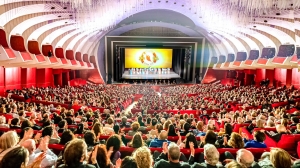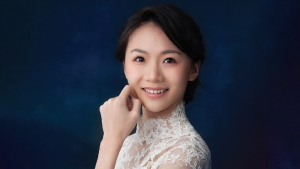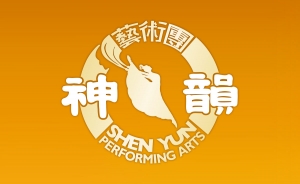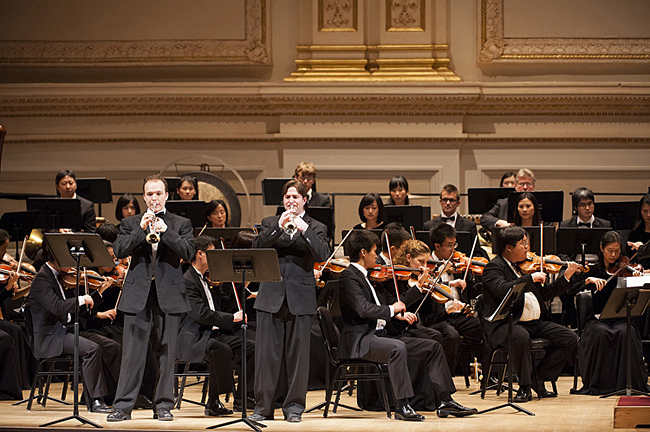
REVIEW: The Soul of Traditional Chinese Music Meets the Grandeur of the Western Symphony
BY AMELIA PANG, THE EPOCH TIMES
NEW YORK—Classical music lovers may think they have heard it all, but the world of classical music has just opened up new boundaries with the Shen Yun Symphony Orchestra’s international debut at Carnegie Hall on Oct. 28.
Shen Yun compositions integrate the strengths of Eastern and Western instruments, creating a sound like no other.
Shen Yun Performing Arts is a classical Chinese dance company based in New York. With a mission to revive 5,000 years of Chinese culture, it has three companies that tour around the world. Each group is accompanied by a Shen Yun orchestra, which comprises both Eastern and Western instruments.
Can a trombone sound like a dung-chen, a Tibetan long horn? Can a violin sound Chinese?
In Shen Yun pieces, they can—and it opens up a whole new world as to what traditional instruments can sound like.
The concert on Sunday opened with The Star Spangled Banner, followed by one of Shen Yun’s eminent opening pieces, Creation.
With the grandeur of a Western symphony orchestra, the majestic brass section resonated throughout the hall, and the percussion set an air of mystery with its Chinese drums. Violins decrescendoed into a tremolo, suggesting that something magical was about to arrive.
Creation is based on an ancient legend that tells of heavenly beings bringing humanity its culture. The melodies are modeled loosely after court music (yayue) from the Tang dynasty (618-907), which is considered the zenith of China’s cultural history.
Classic Gems
The Shen Yun Symphony Orchestra switched from a Chinese flavor to full Western symphonic sound with a flick of the baton. After the mystical Creation, the orchestra performed Antonio Vivaldi’s Concerto for Two Trumpets in C Major, RV 537.
Out of Vivaldi’s 500-odd concertos, this piece is the only one written for two trumpets, here played by Kaspar Märtig and Alexander Wilson.
Märtig is the former principal trumpet of the Dresden Philharmonic Orchestra, and a current member of the Shen Yun Orchestra.
Wilson was the first place winner of the International Trumpet Guild’s 2010 Orchestral Excerpts Competition. He holds a Master’s degree from Arizona State University, and is a member of the Shen Yun Orchestra.
The duo’s intonation was incredibly precise, considering the difficulty of the fast passages and the high range of the notes. Their tone remained bright and weightless throughout the movements.
From the Himalayas to the Forbidden City
The orchestra then returned to several former Shen Yun pieces, such as Khata for the Gods. This song opens with a duet for the clarinet and oboe, and whisks listeners to the vast blue sky of the Himalayas. The wind instruments emitted new sounds to convey the unique feeling of Tibetan tunes, while the trombone used an exotic sliding slur to do a stunning imitation of the Tibetan long horn.
The opening of the song set the scene for a ceremony where Tibetans expressed gratitude toward Buddha for a bountiful harvest. It was followed by a series of sixteenth notes from the strings. The strings’ clean, even notes built toward a climax that illustrated the pattering of feet as people gathered for the ceremony.
The Shen Yun Symphony Orchestra also performed an elegant piece to accompany the dance piece entitled, Ladies of the Manchu Court. The royal ladies walk daintily on shoes with raised platforms at the center rather than the heel— a trademark of the fashion during the period of the Manchu rule (1644–1911).
The noblewomen’s elegance was evoked through a melody captured by a duet of an erhu, a two-stringed instrument, and a muted trumpet.
The erhu, also known as the Chinese violin, has a special capacity to express profound emotions and ideas. No wonder it was selected to capture the exclusive grace of the Manchu court.
Just when the audience was captivated by the sound of the unlikely duet, the violins took over and imitated the erhu’s feeling. While preserving all the richness of traditional violin tones, the Shen Yun Symphony Orchestra violinists added Chinese-style slides on the fingerboard, taking the violin to new musical boundaries.
It was truly a performance like no other, and one that no music lover should have missed.
The Singers
In addition to orchestral performances, the program also included solos from Shen Yun’s singers, who perform using bel canto technique while singing Chinese texts.
All the texts and scores are from original Shen Yun pieces. One of the singers performing was Haolan Geng, who sang for the Guangdong Provincial Opera, winning the gold medal at the first music competition of the Guangdong Festival of Arts.
Geng had remarkable stage presence. Her passionate vibrato moved the audience, and corresponded with the philosophical tone of the text.
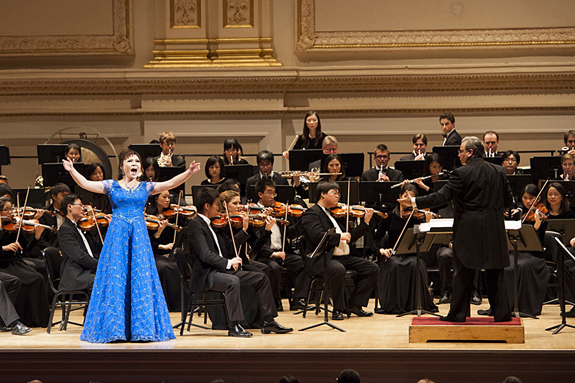
The Carnegie Hall performance was co-conducted by all three Shen Yun Orchestra conductors— Keng-Wei Kuo, Antonia Joy Wilson, and Milen Nachev.
Kuo has expertise in both Western and Chinese music. He holds a bachelor’s degree in Chinese flute, or dizi, and a master’s degree in conducting. He was the founding conductor of Texas’s Taiwan Formosa Chamber Ensemble.
Wilson pursued graduate studies in orchestral conducting at Yale University, and holds a doctoral degree in orchestral conducting from the University of Colorado at Boulder. Wilson was the youngest woman to conduct a major American orchestra. She won first prize at the 1996 International Classical Music Conducting Competition in Mexico.
Nachev was formerly chief conductor and artistic director of several major orchestras in Eastern Europe. He is a graduate of the St. Petersburg Conservatory in Russia.
The Concertmaster was Yo-yo Fann, who earned his masters from the Juilliard School. He is the winner of multiple violin competitions, including the Manhattan School of Music Preparatory Division Concerto Competition for violin and Best Sonata Interpretation at Germany’s Kulturstiftung Hohenlohe International Violin Competition.
The performance ended with a roaring applause that took a long time to fade. Since the performance was co-conducted by three conductors, the audience received a special surprise of three encores.
The encores were excerpts from previous Shen Yun musical favorites. It left the audience anticipating Shen Yun’s 2013 tour, when it will be returning to the Lincoln Center in April.
30 octobre 2012


